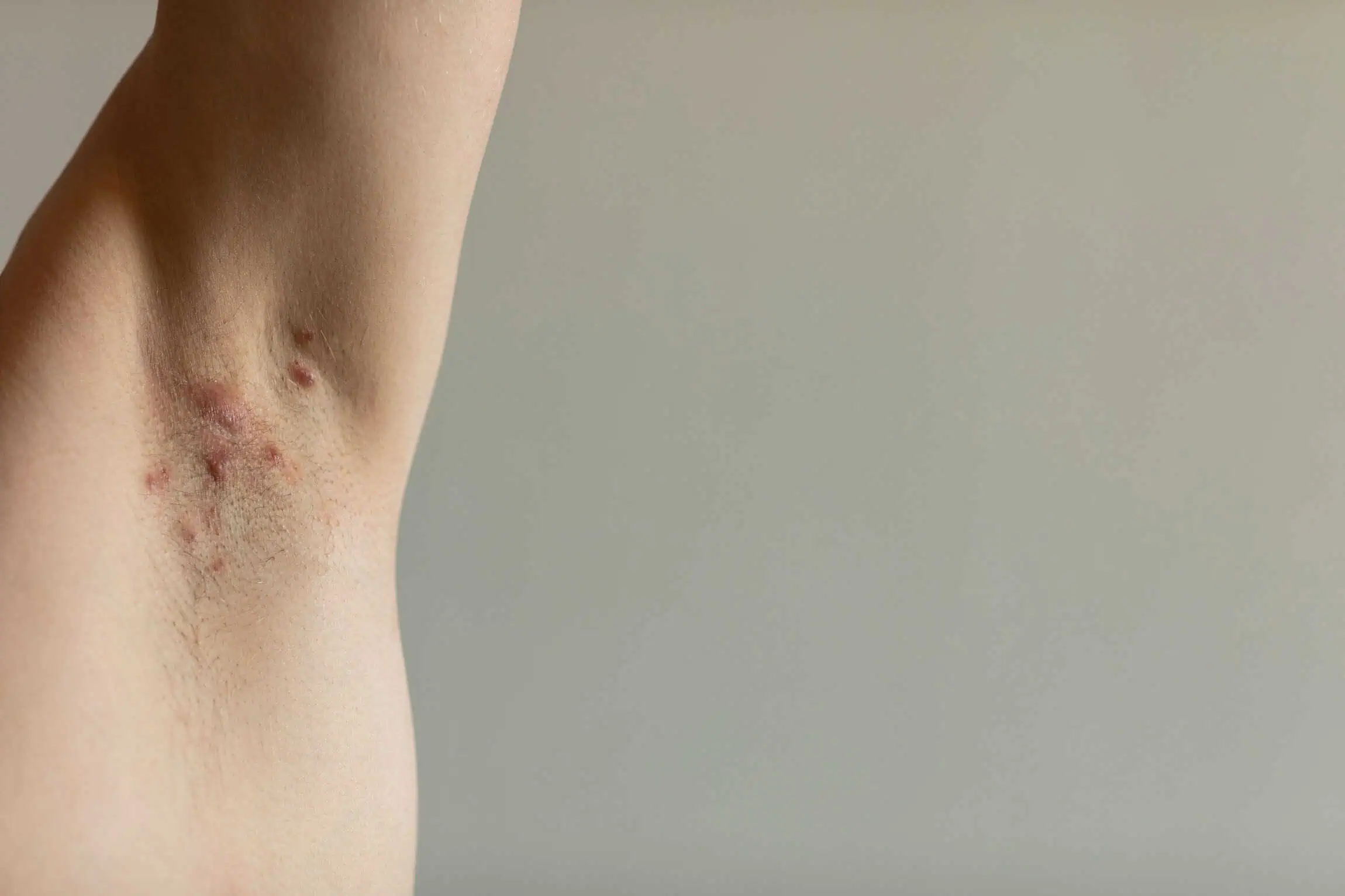Hidradenitis in New York, NY

Hidradenitis in New York, NY
Hidradenitis, also known as Hidradenitis Suppurativa (HS), is a chronic skin condition resulting in painful cysts or lumps in the armpits, groin, and other areas where skin rubs together. These cysts develop due to inflammation of hair follicles and sweat glands, leading to the formation of abscesses that may burst and cause significant discomfort. Hidradenitis can lead to scarring and tunnels under the skin, called sinus tracts, which can complicate the condition further. The exact cause is not entirely known, but early diagnosis and treatment are necessary to managing symptoms and preventing progression.
What Causes Hidradenitis?
Hidradenitis is thought to result from genetic, environmental, hormonal, and lifestyle factors contributing to the inflammation of hair follicles and sweat glands. One of the primary causes is follicular occlusion, where hair follicles become blocked, leading to inflammation and the formation of painful cysts and abscesses. This blockage can be exacerbated by factors such as hormonal changes, particularly during puberty, menstruation, or menopause, which can trigger or worsen symptoms.
Obesity is one significant risk factor, as excess weight can increase skin friction and sweating, creating an environment conducive to inflammation and infection. Smoking is also strongly associated with Hidradenitis, as it can impair the immune system and increase the likelihood of skin irritation and infection. Furthermore, there is a genetic component, with individuals who have a family history of the condition being more likely to develop it. Chronic conditions like metabolic syndrome and Crohn’s disease have also been linked to an increased risk of developing Hidradenitis, suggesting that underlying health issues can contribute to its onset.
What Are the Different Procedures for Treating Hidradenitis?
Drainage and Incision
In cases where cysts become large and painful, a healthcare provider may perform a minor surgical procedure to drain the cysts. This procedure involves making a small incision to allow the trapped fluid or pus to escape, providing immediate relief from pain and pressure. However, this is usually a temporary solution, and cysts may recur.
Medications
Treatment often begins with medications aimed at reducing inflammation and preventing infection. Topical or oral antibiotics can be prescribed to combat bacterial infections that can occur in conjunction with Hidradenitis. Additionally, anti-inflammatory drugs such as corticosteroids can help to reduce swelling and discomfort. In some cases, biologic drugs that target the immune system may be recommended to manage severe or widespread symptoms.
Laser Therapy
Laser treatment can target and destroy hair follicles in the affected areas, reducing the likelihood of cyst formation. This is particularly effective for patients with mild to moderate Hidradenitis and may require several sessions for optimal results. Laser therapy can also help reduce scarring and improve the skin’s overall appearance.
Surgical Removal
For severe cases of Hidradenitis, where cysts are extensive or recurring, surgical removal of the affected skin may be necessary. This procedure involves excising the skin containing the inflamed glands and hair follicles, which can provide long-term relief. Skin grafts may be required to repair the excised areas, and while this approach is more invasive, it is often considered the most effective treatment for advanced cases.
What Are the Results of Treating Hidradenitis?
The results of treating Hidradenitis vary on the intensity of the condition and the treatment approach used. Patients usually experience significant relief from pain and discomfort after treatment, particularly with effective management of inflammation and infection. Early intervention prevents the progression of the disease and lessens the likelihood of scarring. However, as Hidradenitis is a chronic condition, ongoing treatment and lifestyle adjustments may be necessary to manage symptoms and prevent recurrence. The goal of treatment is to improve your quality of life for patients by minimizing flare-ups and promoting skin healing.
If you are experiencing symptoms of Hidradenitis, seeking prompt medical attention can help you manage the condition effectively. At Park Plaza Dermatology in New York, NY, our experienced dermatologists are dedicated to providing customized care and the latest treatments to help you achieve relief. Book an appointment to schedule a consultation and learn more about how we can help you manage Hidradenitis.
Benefits of Treating Hidradenitis
- Relief from pain and discomfort.
- Reduction in the size and number of cysts.
- Prevention of further skin damage and scarring.
- Improved appearance of the affected areas.
- Lowered risk of infection.
- Enhanced mobility and reduced friction in affected areas.
- Reduced need for surgical intervention in the future.
- Better control over flare-ups and disease progression.
- Increased confidence and self-esteem.
- Overall improvement in quality of life.
Frequently Asked Questions
Early signs of Hidradenitis include the formation of tiny, painful bumps under the skin, usually in areas such as the armpits, groin, or under the breasts. These bumps may become inflamed and tender; over time, they can develop into larger cysts or abscesses.
Yes, lifestyle changes play an important role in managing Hidradenitis. Maintaining a healthy weight, avoiding smoking, and wearing loose-fitting clothing to reduce friction can help prevent flare-ups. Additionally, proper hygiene and skin care are crucial for minimizing symptoms.
No, Hidradenitis is not contagious. It is a chronic inflammatory condition which is related to the immune system and is not caused by bacteria or viruses which can be transmitted from person to person.
There is currently no cure for Hidradenitis, but the condition can be effectively managed using the right treatment. Early intervention and consistent care help control symptoms, lessen flare-ups, and improve the overall quality of life for those affected.
Hidradenitis can significantly impact daily life due to the pain, discomfort, and potential for scarring associated with the condition. Flare-ups can make it challenging to engage in physical activities, and visible cysts may affect a person’s self-esteem and social interactions.
If you suspect you have Hidradenitis, it is necessary to consult with a dermatologist for an accurate diagnosis and to discuss treatment options. Early intervention are key to managing and preventing the condition’s progression.
